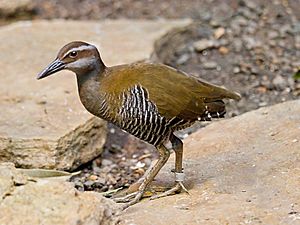Guam Rail facts for kids
Quick facts for kids Guam rail |
|
|---|---|
 |
|
| At the Cincinnati Zoo | |
| Conservation status | |
| Scientific classification | |
| Genus: |
Gallirallus
|
| Species: |
owstoni
|
| Synonyms | |
|
|
The Guam Rail (also known as the Ko'ko in the local Chamorro language) is a special bird that once lived only on the island of Guam. Sadly, you won't find them living freely in the wild on Guam anymore. They are now considered extinct in the wild. This means they only survive in special breeding programs, like in zoos.
Contents
What is a Guam Rail?
The Guam Rail is a medium-sized bird, about 11 inches (28 cm) long. It has brown feathers on its back and a gray belly with white stripes. It also has a long, curved beak and strong legs. Unlike many birds, the Guam Rail cannot fly. Its wings are too small and its bones are not strong enough for flight. This is common for birds that live on islands where there aren't many predators.
Where Did They Live?
Guam Rails used to live all over the island of Guam. They preferred to live in dense forests and thick bushes, where they could hide from danger. They would search for food on the ground, using their beaks to dig and find tasty treats.
What Do They Eat?
Guam Rails are omnivores, meaning they eat both plants and animals. Their diet includes insects, snails, lizards, and even small crabs. They also enjoy eating seeds, fruits, and other plant parts they find on the forest floor.
Reproduction and Life Cycle
Guam Rails build their nests on the ground, hidden in thick vegetation. The female usually lays about two to four eggs. Both parents help to incubate the eggs and care for the chicks once they hatch. The chicks grow quickly and are able to leave the nest after a few weeks.
Why Did They Disappear from the Wild?
The main reason the Guam Rail became extinct in the wild is because of an invasive species: the Brown tree snake. After World War II, these snakes accidentally arrived on Guam, likely on cargo ships. Guam had no natural predators for these snakes, so their population exploded.
The Brown Tree Snake Threat
The brown tree snake is a very good hunter, especially at night. Since the Guam Rail cannot fly, it was an easy target for these snakes. The snakes ate so many Guam Rails that the bird's population quickly dropped. By the 1980s, the Guam Rail was almost completely gone from the wild.
Saving the Guam Rail
Scientists and conservationists realized that the Guam Rail was in serious trouble. To save the species, they started a special program.
Captive Breeding Programs
Before all the Guam Rails disappeared, some birds were caught and brought to zoos and wildlife centers. These places started "captive breeding programs." This means they helped the birds reproduce in a safe environment, away from the snakes. Zoos like the Cincinnati Zoo have played a big part in this effort.
Reintroducing Them to Safe Islands
Once there were enough Guam Rails in the breeding programs, scientists looked for new, safe places for them to live. They found small islands near Guam that did not have brown tree snakes. In 1998, Guam Rails were released onto Rota, a nearby island. This was a big step in bringing the Ko'ko' back! They have also been released on Cocos Island (near Guam) and Palmyra Atoll.
The Guam Rail is a great example of how humans can help save animals from extinction. It shows how important it is to protect ecosystems and prevent invasive species from harming native wildlife.
Images for kids
See also
 In Spanish: Rascón de Guam para niños
In Spanish: Rascón de Guam para niños



